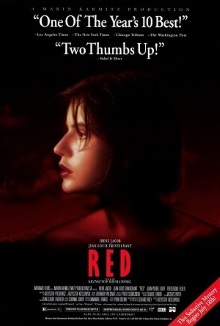
The two previous entries of the trilogy starred female leads who were already known to me. Rouge stars Irène Jacob, an actress I know nothing about and who seems to have become famous mainly since appearing in Krzysztof Kieślowski’s previous film La Double vie de Véronique. Yet she is easily the most beautiful and charming of the three. Appropriately enough, for as some reviewers have put it, she plays the role of Beauty against Truth as incarnated in the person of Jean-Louis Trintignant’s Joseph Kern.
Set entirely in Geneva, the film recounts the unusual relationship that develops between Jacob’s Valentine Dusseau, a student who also works part-time as a model, and Joseph, a retired judge. One evening, she accidentally runs over a dog that turns out to belong to Joseph. She tries to return the injured dog to her owner but is nonplussed when he simply states that she now owns the dog. In a series of later encounters as she cares for the dog, she further learns that he has a habit of eavesdropping on the telephone conversations of his neighbors and passing judgment upon them.
Another story occurs in parallel, that of budding jurist Auguste Bruner and his girlfriend. He lives across the street from Valentine and they inhabit the same spaces, yet their paths never cross and they never meet each other. But as Valentine gets to know Joseph and his past, we, the audience, become uncomfortably aware that there are eerie symmetries between Auguste and Joseph.
There are multiple, overlapping themes in Rouge rather than the singular focus and intensity of Bleu. As befits its place as corresponding to the third value of the French national motto, fraternité, there is a sense that people are all connected even if only in some ineffable and inarticulable way, as exemplified in the ubiquitous telephones in this film. It’s also about the cynical Joseph finding some form of redemption from the regrets of his life and Valentine learning the limits of innocence.
In line with the thematic complexity, the camera here is more dynamic, with the opening shot that seamlessly introduces both Valentine and Auguste being especially impressive. There is a tendency to place characters on different levels and have the camera switch between them. The acting lacks the intensely personal intimacy of Bleu, but this is more than made up for in the fascinating interactions between Jacob and Trintignant, both of whom incorporate the ideals they represent perfectly.
It took reading through critiques written by other people to make me realize why this film, and no doubt others by Kieślowski, hangs together so perfectly. The themes reinforce each other through similar motifs that show up again and again. An obvious example is the recycling bin that appears in all three films with the reaction of the protagonist being a direct statement of what each film is about. A more subtle one is when Valentine enters Joseph’s house and notices that a photograph of a dancer hangs prominently inside and it is later revealed that she is herself also a dancer.
One of the things that amuse me the most about this film is how one can interpret Joseph as being an entity with God-like characteristics. He appears to know more than can be plausibly explained by his eavesdropping activities and seems to be conscious that Auguste is walking in his own footsteps. There are even hints that he has deliberately manipulated events to unfurl as he wishes. Yet I don’t feel cheated by this mysticism. Indeed it only reinforces the theme that people are connected in ways that can’t be easily explained. Compare this to the hamfisted appeal to the power of love in Interstellar.
Having watched the entire trilogy, I concur with the consensus that Blanc is dismissible and feels like a strange misstep. Between the other two, Bleu is more emotionally powerful, like a tide comes in and sweeps you away. Rouge even if it references forces that are beyond rationalization feels to me the most intellectual, the story that is really about themes and ideas rather than these specific characters. For this reason, it is my favorite of the three.